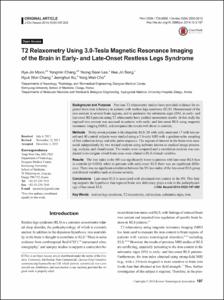T2 Relaxometry Using 3.0-Tesla Magnetic Resonance Imaging of the Brain in Early- and Late-Onset Restless Legs Syndrome
- Keimyung Author(s)
- Moon, Hye Jin; Cho, Yong Won; Chang, Hyuk Won; Ku, Jeong Hun
- Department
- Dept. of Neurology (신경과학)
Dept. of Radiology (영상의학)
Dept. of Biomedical Engineering (의용공학과)
- Journal Title
- Journal of Clinical Neurology
- Issued Date
- 2014
- Volume
- 10
- Issue
- 3
- Abstract
- Background and Purpose:
Previous T2 relaxometry studies have provided evidence for regional brain iron deficiency in patients with restless legs syndrome (RLS). Measurement of the iron content in several brain regions, and in particular the substantia nigra (SN), in early- and late-onset RLS patients using T2 relaxometry have yielded inconsistent results. In this study the regional iron content was assessed in patients with early- and late-onset RLS using magnetic resonance imaging (MRI), and compared the results with those in controls.
Methods:
Thirty-seven patients with idiopathic RLS (20 with early onset and 17 with late onset) and 40 control subjects were studied using a 3.0-tesla MRI with a gradient-echo sampling of free induction decay and echo pulse sequence. The regions of interest in the brain were measured independently by two trained analysts using software known as medical image processing, analysis, and visualization. The results were compared and a correlation analysis was conducted to investigate which brain areas were related to RLS clinical variables.
Results:
The iron index in the SN was significantly lower in patients with late-onset RLS than in controls (p=0.034), while in patients with early-onset RLS there was no significant difference. There was no significant correlation between the SN iron index of the late-onset RLS group and clinical variables such as disease severity.
Conclusions:
Late-onset RLS is associated with decreased iron content in the SN. This finding supports the hypothesis that regional brain iron deficiency plays a role in the pathophysiology of late-onset RLS.
- Publisher
- School of Medicine
- Citation
- Hye-Jin Moon et al. (2014). T2 Relaxometry Using 3.0-Tesla Magnetic Resonance Imaging of the Brain in Early- and Late-Onset Restless Legs Syndrome. Journal of Clinical Neurology, 10(3), 197–202. doi: 10.3988/jcn.2014.10.3.197
- Type
- Article
- ISSN
- 1738-6586
- 파일 목록
-
-
Download
 oak-aaa-2766.pdf
기타 데이터 / 587.95 kB / Adobe PDF
oak-aaa-2766.pdf
기타 데이터 / 587.95 kB / Adobe PDF
-
Items in Repository are protected by copyright, with all rights reserved, unless otherwise indicated.